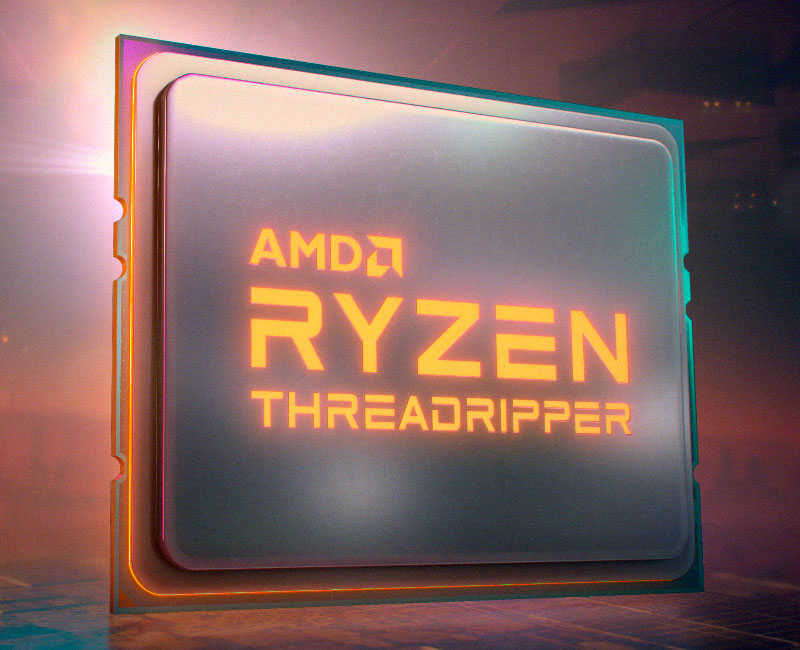AMD Lists Threadripper 3000 CPU With 32 Cores, Possible New Socket
Famed chip detective @KOMACHI_ENSAKA discovered that AMD has posted a new Product Master list to its website that outlines current and potential future products. As per normal, entries to this list may or may not make it to market, but it seemingly provides some very intriguing information about AMD's Ryzen Threadripper 3000-series (codename Castle Peak) processors.

Third-Generation Threadripper 3000 Specifications
Starting with the most obvious new information, AMD lists an unidentified Ryzen Threadripper with 32 cores and a 280W TDP (thermal design power). The Ryzen Threadripper 2990WX, AMD's previous flagship, is rated for 250W. That's a 30W (12%) difference and hints that the new third-generation Ryzen Threadripper chips will probably be limited to 32 cores, which is the same as the prior-gen chips. There also isn't a listing for the rumored 64-core Threadripper.
CPK DT Ryzen Threadripper 16C 280W SP3R3 DT Ryzen Threadripper 280W SP3R3 DVT CPK DT Ryzen Threadripper 280W SP3R3 EVT DT Ryzen Threadripper 2E24 280W SP3R EVT CPK DT Ryzen Threadripper 32C 280W SP3r3 DT Ryzen Threadripper 280W SP3r3 DVT DT Ryzen Threadripper 32C 280W SP3r3 EVT CPK DT Ryzen Threadripper 280W SP3r3 EVT DT Ryzen Threadripper 2E32 280W SP3r3 EVT DT Ryzen Threadripper 2832 280W SP3r3 EVT DT Ryzen Threadripper 2E32 280W SP3r3 EVT
The other tidbit revolves around the socket for Threadripper 3000 processors. As you recall, first-and second-gen Ryzen Threadripper processors drop into socket TR4, also called socket SP3r2. The new document references a socket SP3r3 (presumably TR4+), which would be the third revision to the existing SP3 socket.
The potential socket change could be attributed to the rumored support for eight-channel memory, so you might need to drop some cash on a new motherboard to expose the full features of some Threadripper 3000 models.
AMD has already registered three new chipsets (TRX40, TRX80 and WRX80) with the USB Implementers Forum (USB-IF) back in August. Rumor is that the TRX80 and WRX80 chipsets could come with support for eight memory channels. If so, the chipsets could warrant a new socket, which in this case would be socket SP3r3.
We won't have to wait long to find out as the Ryzen Threadripper 3000-series chips are scheduled to come out next month. Surprisingly enough, AMD previously sent over marketing material promoting a 24-core part. There's a good chance that the 32-core chip won't be available at launch.
Get Tom's Hardware's best news and in-depth reviews, straight to your inbox.

Zhiye Liu is a news editor, memory reviewer, and SSD tester at Tom’s Hardware. Although he loves everything that’s hardware, he has a soft spot for CPUs, GPUs, and RAM.
-
jimmysmitty From the sounds of it I think there is going to be a bit of a mess to get clarified from AMD on TRs future. 3 chipsets and word of different memory configurations make this one to wait and see the official announcement.Reply
If AMD is planning to add memory channels then there would need to be a new socket to add more pins to support the additional channels. However they could still have cheaper CPUs that run half the memory channels supported much like Intel did with the Kaby Lake LGA 2011 CPUs that were pointless. -
cryoburner Reply
How is having 3 HEDT chipset options a concern? Intel's current mainstream desktop chips alone have way more than that, with H310, B360, B365, H370, Q370, Z370 and Z390, each with differing feature-sets. Then there's their two HEDT/Workstation chipsets for the LGA 2066 socket, X299 for Core-i9s and C422 for Xeon Ws, with the latter offering support for different memory configurations with ECC and additional PCIe lanes.jimmysmitty said:From the sounds of it I think there is going to be a bit of a mess to get clarified from AMD on TRs future. 3 chipsets and word of different memory configurations make this one to wait and see the official announcement.
Logically, based on the names, one might assume TRX40 would support quad-channel memory, while TRX80 and WRX80 would offer eight-channel memory support. The WRX chipset will probably target the Xeon W market, while the other two will likely be aimed more at the Core-i9 HEDT market. Not everyone needs eight-channel memory, so making a lower-priced offering available without it seems reasonable.
Not necessarily. Typically some pins are left unused on a socket for future expansion. TR4 has 4094 pins, and there's high likelihood that a number of them are unused. So, it's certainly possible that the same chips could run in quad-channel mode on existing motherboards, while utilizing previously unused pins for eight-channel memory support on the new boards. In fact, AMD's EPYC server processors already use a physically identical SP3 socket while offering not only eight-channel memory, but also double the PCIe lanes, so the pins are clearly already there to make that happen.jimmysmitty said:If AMD is planning to add memory channels then there would need to be a new socket to add more pins to support the additional channels. However they could still have cheaper CPUs that run half the memory channels supported much like Intel did with the Kaby Lake LGA 2011 CPUs that were pointless. -
jimmysmitty Replycryoburner said:How is having 3 HEDT chipset options a concern? Intel's current mainstream desktop chips alone have way more than that, with H310, B360, B365, H370, Q370, Z370 and Z390, each with differing feature-sets. Then there's their two HEDT/Workstation chipsets for the LGA 2066 socket, X299 for Core-i9s and C422 for Xeon Ws, with the latter offering support for different memory configurations with ECC and additional PCIe lanes.
Logically, based on the names, one might assume TRX40 would support quad-channel memory, while TRX80 and WRX80 would offer eight-channel memory support. The WRX chipset will probably target the Xeon W market, while the other two will likely be aimed more at the Core-i9 HEDT market. Not everyone needs eight-channel memory, so making a lower-priced offering available without it seems reasonable.
Not necessarily. Typically some pins are left unused on a socket for future expansion. TR4 has 4094 pins, and there's high likelihood that a number of them are unused. So, it's certainly possible that the same chips could run in quad-channel mode on existing motherboards, while utilizing previously unused pins for eight-channel memory support on the new boards. In fact, AMD's EPYC server processors already use a physically identical SP3 socket while offering not only eight-channel memory, but also double the PCIe lanes, so the pins are clearly already there to make that happen.
Mainstream is not HEDT. Intel has always had two in HEDT, one for high end one for Xeon based WS.
Unless they planned that far ahead I don't see any way to not need a new socket and I also did mention the ability to run quad channel in an 8 channel system, just like Intel did with 2011 Kaby Lake that was dual channel in a quad channel board.
We will see when AMD officially launches the product. It would not surprise me if they do have a new socket. HEDT should be top of the line and pushing boundaries, not trying to fit into an old platform. -
joeblowsmynose I didn't read through the comments (short on time) so forgive me if this has already been considered ...Reply
14nm TR 32 core has 250w TDP ... 7nm TR 32 core has 280w TDP ... 64 core 7nm Epyc has 280w TDP ...
This makes me wonder what sort of clocks are we going to see in Zen2 Threadripper 24 and 32 core parts? Did AMD really just save all the chiplets that binned really poorly on power efficiency for TR? Not bloody likely ...
And of course the 32 core having a 280w TDP does NOT really indicate a 64 core won't exist. Look at Intel 10th gen HEDT TDPs ... their 8 core has the exact same "TDP" as their 18 core. (well over 100% more cores with same TDP)
So a 64 core 280w TDP could easily be incoming with lower clocks - perhaps more akin to what is seen in Epyc. With 64 cores, you don't need high clocks and won't be doing any type of work that relies ion high clocks (like professional gaming)
Again, if we're up 30 watts at the same core/thread count at almost half the node size for the 32 core, there has to be some really interesting clockspeeds incoming on zen2 TR ...
Granted there's any truth to the leaks ...